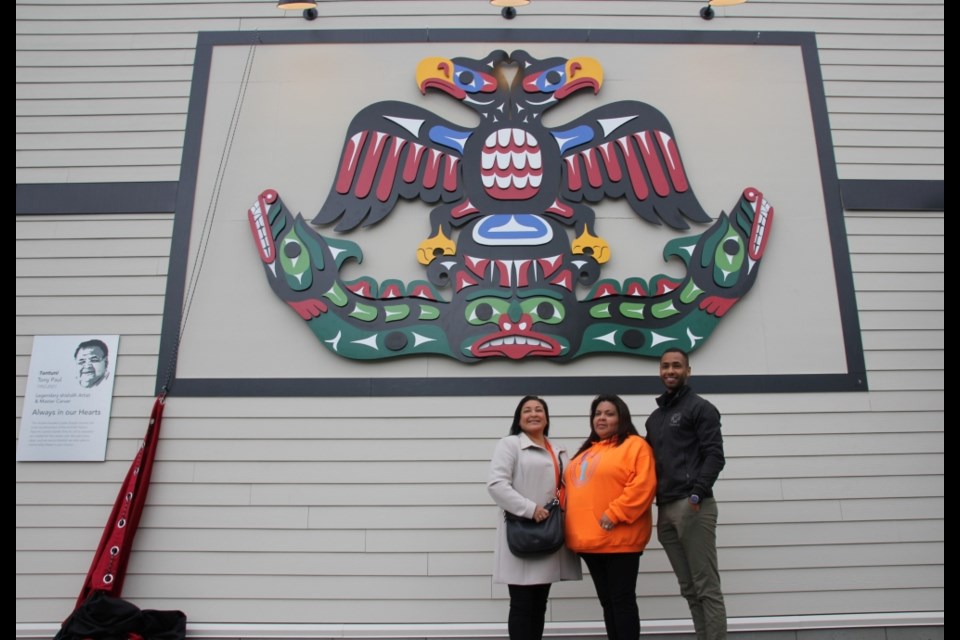As rain fell on the overcast morning of June 16, so did the large red curtain, unveiling a memorial to master carver ?antuni Tony Paul of shíshálh Nation.
The large, colourful piece created by the late artist himself depicts the double-headed k’aykw (eagle), one of shíshálh Nation’s most sacred symbols, on top of ch’inkw’u (or Tsain-Ko), the double headed serpent.
As his youngest daughter, Chelsea, pulled the curtain aside, the gathered crowd broke out in applause. The piece is showcased on the side of the Lordco building at the Tsain-Ko Centre mall, where it joins more shíshálh artwork commissioned by the centre.
‘He was my greatest supporter’
His oldest daughter, council member Alvina Paul, thanked the crowd of more than 60 people for attending the ceremony for her father’s memorial and the tribute to his life.
“He was my greatest supporter, as a child. He was a great father to us.” As she teared up, Alvina said, “It’s a bit of an emotional unveiling because it is so meaningful to us.” Even though they hadn’t coordinated it, Alvina and her sister Jillena both wore orange, she pointed out. “We wear what represents him.”
Tony was a survivor, having lived in a residential school for more than a decade. But “the orange represented much more than just him being a residential school survivor,” Alvina told Coast Reporter after the ceremony. “It represented him as being the goalie for the Sechelt Renegades.”
Sechelt Renegades soccer star
Tony was the original goalie for the soccer team, who he played with for 25 years, travelling provincially and even internationally to Hawaii in 1981. A star player, many of Tony’s saves at the net were recorded in the Peninsula News and Coast News, and he went on to coach youth soccer as well.
As he played the game, Tony would give it his all and come off the field limping, covered in scrapes and bruises, even with cracked ribs, Alvina said. And it gave pride to Tony’s children and the shíshálh Nation, as the team represented the entire community. “It bonded so many men. I adore all of them, for being on the field was my dad… They were a dynasty.”
shíshálh Nation hiwus (chief) Warren Paull said he’d known Tony all his life. After the ceremony, hiwus Paull said, “It’s an unfortunate event to have him pass. Our community’s not untouched by COVID, same as every other community. He leaves behind a fantastic legacy. We miss him, and I’m glad that this is here to show who he was, what he was, and what his passion was.”
‘His style was very unique’
hiwus Paull said he has several of Tony’s pieces in his home, and commented on the vivid colours he used in this piece. The basics never change, hiwus Paull said, but everyone adds their own flair.
“You always know a Tony — a Tony art piece — because his style was very unique,” hiwus Paull said. “He was pretty creative that way. And I hope our youth are watching and those who have an artistic bent learn from it.”
Tony began carving as a teen, and was self-taught before he spent several years under master carver Richard Krentz. “I think he found healing in it from any of the experiences he had from residential school,” Alvina said.
At the 2015 unveiling of the totem poles he carved for the Sechelt Hospital, Tony said, “Like all artists, I carve to express my inner feeling. I want to bring to life the traditional art of the shíshálh Nation and to bring these cultural symbols to a worldwide audience for their understanding and appreciation. Totem poles are a declaration, a document.”
syíyáyá Reconciliation Movement
Tony was also working on the Reconciliation Pole, which is to be placed at the site of where St. Augustine’s Indian Residential School once stood. In November 2021, Tony and his wife Cindy August died from COVID. About 20 per cent of the pole remains unfinished, Alvina said, and the syíyáyá Reconciliation Movement has hired another carver to continue his work. In 2019, when Tony started the pole, the public was invited to carve a notch into the 10-metre cedar log as its transformation began.
Alvina recalls arriving home from school to the smell of cedar and knowing her father was working on something new. “I’d run in to see what he was creating, because it was always so wondrous to watch him sit there and whittle away at this piece of wood. Just this piece of wood you’d find and turn into … a beautiful piece of art.”
He became known for his intricate cuts as if he had “surgeons hands, to be so precise,” she said.
His talent lives on
Each work would tell a story, honouring ancestors by carrying their legends, and representing the clans from the inlet. He often gravitated, she said, to the double-headed eagle and ch’inkw’u.
To have so many people turn up to the June 16 event despite the rain, Alvina said, “shows how much respect my dad gave people, for them to give it back.”
His talent lives on, both in his art and in his grandchildren. “My dad’s artistic ability has carried on through our bloodline,” Alvina said. “It’s really nice to see that they did inherit some of his artistic genes.”
This year, Alvina was reconnected with a piece of art Tony crafted many years ago: the only silver carving he ever made. Her dad visited a relative in a dream, saying it was time to give it to her. The teardrop pendant holds an eagle, the animal Tony would revisit in his artwork time and again. Alvina said she will wear it with honour.



